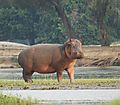Hippopotamus
Parent page
On this page
Introduction to Hippopotamus
Description and Characteristics
There are two species of hippopotamuses; the Pygmy Hippo and the river or common hippopotamus. The Pygmy Hippo is the smaller species, standing about waist-high to an adult human the common/river hippopotamus is world's third largest and heaviest land animals, weighing up to about 4,000 kg.
Both species of hippos have barrel-shaped bodies, short stocky legs, and smooth almost hairless skin. Their heads appear outsized with unusually broad mouths and their facial features resemble those of a pig. Hippos have a short, tufted tail
Hippos have thin skin that dries out quickly - they secrete a pinkish coloured oil that helps them keep their skin moist in the hot African climate. Hippos spend most of their days in the water or wallowing in the mud, generally coming up on land to feed at night.
River hippos are one of the most feared animals in southern Africa. It is claimed that every year more people are killed by them than by any other African animal.
Out of water, hippos are surprisingly fast runners; a fully grown river hippo can run 30 km/h for a few hundred yards.
Feeding/drinking Habits
Hippos are Herbivores, preferring short grasses of the African plains. Their muscular lips are almost 70 cms wide which makes them extremely efficient grazers. They generally feed during the night, grazing for up to 5 hours before returning to the water.
Habitat
The Pygmy hippo lives in West Africa's forest belt, primarily in Liberia and Côte d’Ivoire and spends more of its time near water rather than in it, and dives beneath the water surface only when in imminent danger of attack.
The common hippopotamus is found in western, central, eastern and southern parts of Africa, living in lakes and rivers near grasslands, usually where the water is deep and slow-flowing.
Size and Lifespan
Male hippos are generally larger and heavier than females. Common Hippos range from 3.96 to 4.57 mtrs long, standing 1.52 mtrs at the shoulder height and weighing between 1,800 to 3,600 kgs. They live for up to anywhere between 20 to 40 years in the wild. Whilst Pygmy hippos grow to about 1.75 m long, and have a maximum weight of about 275 kg
Reproduction
Males reach sexual maturity at 7 years and females at 9 years. Mating always occurs in water during the dry season. Hippos have a gestation period of about 7 months and usually birth is given to a single calf during the start of the raining season. River hippos of the give birth usually in shallow water therefore calves are able to swim from birth. The average birthing interval is about 2 years
Predators and Threats
Pygmy Hippos are very rare in the wild, with hunting and deforestation having declined their numbers over recent years. Hippo calves are vulnerable to attack by lions and hyenas on land and by crocodiles in the water. People hunt hippos for their meat and hide and also for their tusks, which are sold as ivory. They are also hunted because they are potentially dangerous and destructive particularly in areas where crops are grown.






















